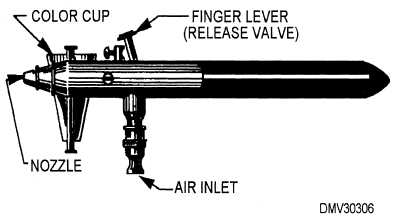Airbrushes
Introduction
Airbrushes
Airbrush art combines the graphic qualities of illustration with the continuous
tones of photography. Although you may not have the opportunity to
practice traditional airbrush techniques, you probably have an airbrush effects
option in the graphics software of your computer. Understanding the
principles of traditional airbrush rendering will help you maximize computer-
generated airbrush options. For further study of airbrush art, review the
work of contemporary super-realist Audrey Flack or the forties pin-ups of
Vargas.
Airbrushes are precision tools that combine liquids such as paints, inks, and
water with compressed air to create a fine mist or spray. The spray from the
airbrush applies paint in soft tonal gradations ranging from the highest
discernable tint of color to complete opacity. All airbrushes have a color cup
or bottle to hold pigment, an inlet for compressed air, a nozzle through which
paint is sprayed under pressure, and a release valve (finger lever) that enables
the operator to use air to propel the paint and to control the amount of air and
paint that comes out of the nozzle. The three basic types of airbrush are the
single-action, the double-action, and the oscillating airbrush. The main
differences in airbrushes are their sensitivity and control.
Figure 6-1 shows the parts of an airbrush.
Figure 6-1.—Airbrush nomenclature.
Continued on next page
6-3


